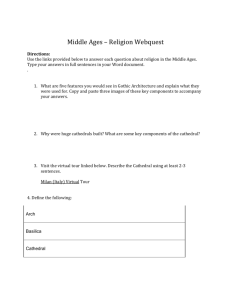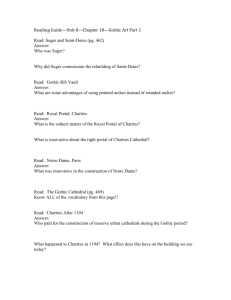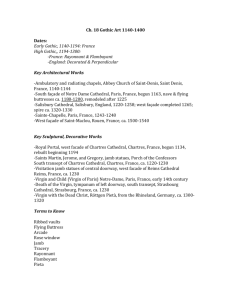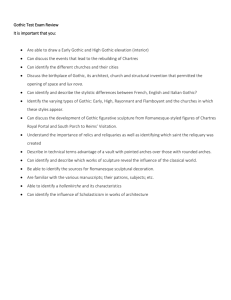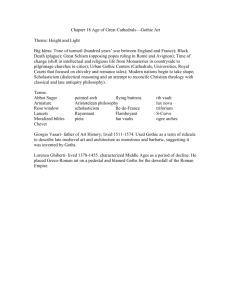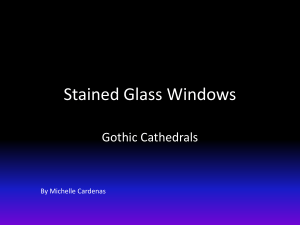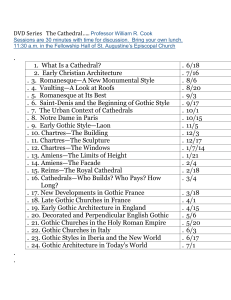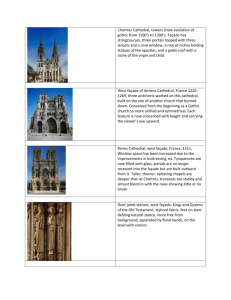Chapter 18 The Age of Great Cathedrals
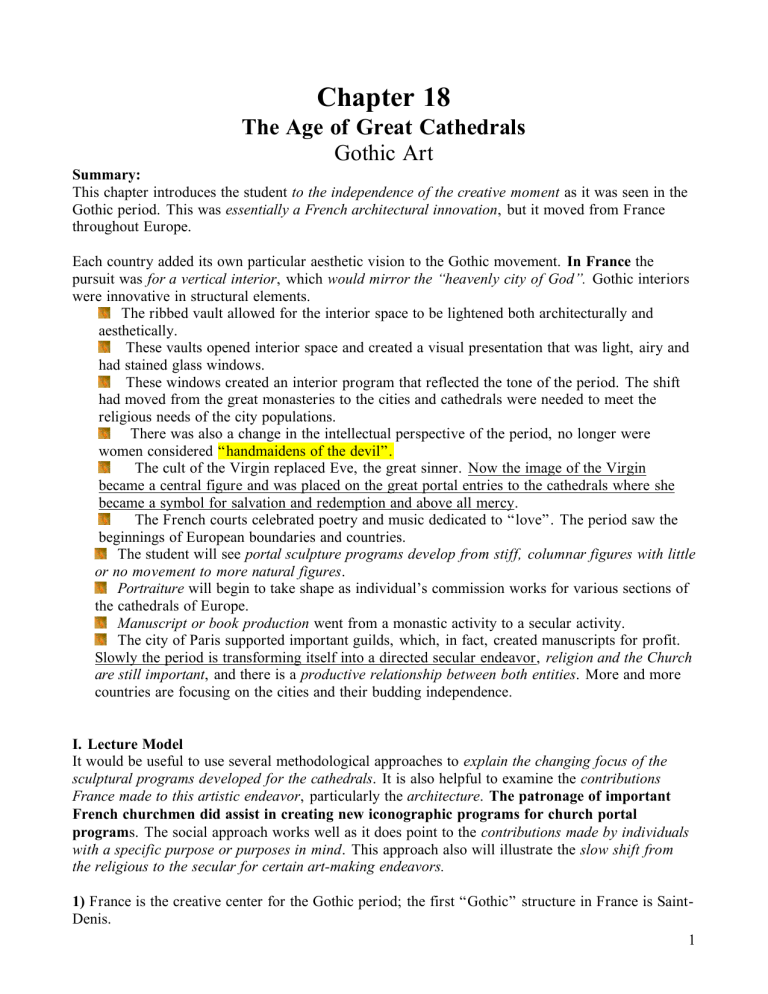
Chapter 18
The Age of Great Cathedrals
Gothic Art
Summary:
This chapter introduces the student to the independence of the creative moment as it was seen in the
Gothic period. This was essentially a French architectural innovation , but it moved from France throughout Europe.
Each country added its own particular aesthetic vision to the Gothic movement. In France the pursuit was for a vertical interior , which would mirror the “heavenly city of God”.
Gothic interiors were innovative in structural elements.
The ribbed vault allowed for the interior space to be lightened both architecturally and aesthetically.
These vaults opened interior space and created a visual presentation that was light, airy and had stained glass windows.
These windows created an interior program that reflected the tone of the period. The shift had moved from the great monasteries to the cities and cathedrals were needed to meet the religious needs of the city populations.
There was also a change in the intellectual perspective of the period, no longer were women considered “ handmaidens of the devil”.
The cult of the Virgin replaced Eve, the great sinner. Now the image of the Virgin became a central figure and was placed on the great portal entries to the cathedrals where she became a symbol for salvation and redemption and above all mercy.
The French courts celebrated poetry and music dedicated to “love” . The period saw the beginnings of European boundaries and countries.
The student will see portal sculpture programs develop from stiff, columnar figures with little or no movement to more natural figures .
Portraiture will begin to take shape as individual’s commission works for various sections of the cathedrals of Europe.
Manuscript or book production went from a monastic activity to a secular activity.
The city of Paris supported important guilds, which, in fact, created manuscripts for profit.
Slowly the period is transforming itself into a directed secular endeavor, religion and the Church are still important , and there is a productive relationship between both entities . More and more countries are focusing on the cities and their budding independence.
I. Lecture Model
It would be useful to use several methodological approaches to explain the changing focus of the sculptural programs developed for the cathedrals . It is also helpful to examine the contributions
France made to this artistic endeavor , particularly the architecture . The patronage of important
French churchmen did assist in creating new iconographic programs for church portal program s. The social approach works well as it does point to the contributions made by individuals with a specific purpose or purposes in mind . This approach also will illustrate the slow shift from the religious to the secular for certain art-making endeavors.
1)
France is the creative center for the Gothic period; the first “Gothic” structure in France is Saint-
Denis.
1
18-01 Ambulatory and radiating chapels, abbey church, Saint-Denis,
France, 1140-1144.
The ambulatory ( 18-1 ) becomes the focus of the new movement that came about as a result of the innovative ribbed vault construction . The walls became a pierced surface of windows. Unlike Romanesque churches that had dark interiors, this new structural element allowed for light to come into the church . This light became the lux nova or new light , a hallmark of the Gothic period .
As the period developed and evolved, construction spread throughout France. The great cathedrals became the centers of town life. Chartres is just such a community.
The exterior sculptural programs were carefully developed to create an atmosphere , which would reflect this community as a center of learning .
The royal or west portal created a tableau that mirrored medieval leaning. This was a partnership between the religious and the intellectual sides of 12th century France. The sculptural program developed, perhaps by Thierry of Chartres , combined the concepts of spiritual and secular lives.
As the period evolves, the sculptural programs become more fluid and relaxed in pose.
18-06 18-15
18-06 Old Testament kings and queens, jamb statues, central doorway of Royal Portal, Chartres
Cathedral, Chartres, France, ca. 1145-1155.
18-15 Saints Martin, Jerome, and Gregory, jamb statues, Porch of the Confessors (right doorway), south transept, Chartres Cathedral, Chartres, France, ca. 1220-1230.
The comparison between figures from the Royal Portal ( 18-6 ) and the South Transept Portal
( 18-15 ) of Chartres points to the evolving character of sculptural programs.
In the Royal Portal figures, Old Testament Queen and Kings (c.1145-55) have a columnar quality that does not allow the figures to move within the space they occupy on the portal.
In the South Transept portal, the figures (c.1220-30) take on the space and occupy it. They stand in the presence of the viewer and articulate their faith and commitment to and with the
2
viewer . These figures also represent the history of the Church; they are saints who have made contributions beyond martyrdom .
17-24 Isaiah/Jeremiah from Saint-Pierre; Moissac
As the period evolved, so did the iconography of the exterior church programs. Salvation and redemption are emphasized rather than sin and damnation ,
A comparison with the trumeau figure of Isaiah/Jeremiah from Saint-Pierre; Moissac ( 17-
24 ) demonstrates how far exterior sculptural designs have gone.
The movement of the figures, Sts. Martin, Jerome and Gregory, is more natural and real when compared to the jittery, frenzied movement of the Isaiah/Jeremiah figure.
The exaggerated movement has relaxed into a calm and reconciled presentation that has a foundation, not only in the natural evolution of art, but also in the intellectual development of the period.
This is the period of Thomas Aquinas (c.1225-74), a period when the intellectual process was dedicated and focused on answering the questions of divinity and humanity .
Thomas Aquinas developed 631 questions and responses based on reasoned arguments . He developed a rational response to the medieval dilemma of the “inherent evil of women” and countermanded this argument by posing a refutation of Aristotle’s claim
: woman was a defective male .
Thomas Aquinas presents his argument by posing the question and presenting the arguments both in opposition and agreement .
The intellectual force of this synthesis of thought also contributed to the age and to the positioning of women .
The presentation of women on portal sculpture becomes an integral component for these programs.
18-22 Visitation, jamb statues of central doorway, west facade, Reims
Cathedral, Reims, France, ca. 1230.
3
The sculptural program developed for Reims Cathedral is an example of the range the sculpture has reached.
The Visitation ( 18-22 ) as conceived on the West facade of Reims creates a sympathetic and believable dialog between the two women and the viewer .
The knees of the women are cocked and relaxed as if standing, naturally, in place, an observable motif incorporated into the figures .
Comparing the Annunciation from Reims illustrates how developed the Visitation is.
The Annunciation has the same quality as the Chartres Royal Portal figures, stiff and rigid, visibly as well as intellectually attached to the structure.
The sense of movement and space the Visitation attains is absent from the
Annunciation. The two women stand relaxed and posed within the space they occupy,
They then go on to articulate the article of faith, acknowledgement of the divinity of the child in the womb. This moment does indicate the change in the role of women within the
Church and without .
Elizabeth and Mary stand as partners in the Church and as role models in Gothic society, women who have made profound contributions: the mother of John the Baptist and the mother of God.
Gothic outside of France took on the national character of the creating culture, for example,
18-37 18-21
Salisbury Cathedral Reims Cathedral
Gothic church architecture in England has decidedly different character.
Salisbury Cathedral ( 18-37 ) does not have the same vertical exterior that is seen in
French cathedrals and chapels ( 18-21 ).
Rather the English model follows a preference for a screened facade , this exterior does not soar but creates a solid and massive presence.
This is the diversity of choice that becomes a national identity.
4
That same diversity in architecture is also developed in sculpture.
18-48 Death of the Virgin, tympanum of left doorway, south transept, Strasbourg Cathedral, Strasbourg, France, ca. 1230
For example in Germany, the focus is on the great emotion of the portrayal .
In the tympanum of Strasbourg Cathedral ( 18-48 ), we witness a death, the Death of the
Virgin . Within the surface of the tympanum, the figures are curving and balancing the event of the Apostles and the Virgin.
She is stretched out on the bed in death; being wrapped in her death shroud, accompanied by the mourning Apostles, centered in the middle of the scene is the figure of Christ representing redemption.
The entire scene moves in harmony by the balance and counter-balance, the emotion is contained yet real and evident.
A more overt emotional presentation is the Rottgen Piet` a. The skeletal, broken body of the
Christ figures keenly presents his suffering and death in vivid detail. The high emotion of the moment is emphasized and depicted in excruciating drama.
A comparison with this drama is the Pestkreuz; here the crucifixion is rendered in exaggerated detail. The figure of Christ hangs on the X-shaped cross. Both depictions compliment each other and both are reminiscent of the creating culture.
5
18-31 Blanche of Castile, Louis IX, and two monks, dedication page (folio
8 recto) of a moralized Bible, from Paris, France, 1226-1234. Ink, tempera, and gold leaf on vellum, 1'3" X 10 1/2".
2) In manuscript depiction there has been a change as well. In the Moralized Bible ( 18-30 ),
The depiction is God the Father in the act of creating the World; however, not according to
Genesis.
Here we see the figure of God as an engineer or architect or mason, using the tools of construction in order to create the world. Gone is the abstract rendering of God and now a worker familiar with and knowledgeable about geometry, so essential for architecture has replaced him.
18-32 Abraham and the three angels, folio 7 verso of the Psalter of Saint
Louis, from Paris, France, 1253-1270. Ink, tempera, and gold leaf on vellum, 5" X 3 1/2".
Bibliothèque Nationale, Paris.
In the Psalter of St. Louis a comparison can be made using the illumination, which shows
“Gideon’s Army Surprises the Midianites”. Here too is a contemporary presentation of an Old
Testament text. The armies are garbed in contemporary military wear.
Once again the development of the period has allowed the artist to create a more contemporary dialog for the viewer. We are treated to seeing contemporaneous costumes and seeing them as the Gothic viewer saw them.
Resources:
Videotapes
Art and Life in the Middle Ages: Luttrell Psalter 36 min. BVL9045 $149.95
Art in the Age of Alfonso el Sabio 25 min. BVL2379 $89.95
6
Ave Maria 51 min. BVL5286 $89.95
The Jeweled city: The Cathedral of Chartres 50 min. BVL7624 $149.95
99
Films for the Humanities
1-800-257-5126 http://www.films.com
Notre Dame, Cathedral of Amiens CP-5375W $39.95
Crystal Productions http://www.crystalproductions.com
Books
Camille, Michael. Gothic Art: Glorious Visions. New York: Harry N. Abrams, 1996.
Coldstream, Nicola. The Decorated Style: Architecture and Ornament 1240-1360.
Toronto; Buffalo: University of Toronto Press, 1994.
Erlande-Brandenburg, Alain. Notre-Dame de Paris. New York: Harry N. Abrams, 1998.
Grant, Lindy. Abbot Suger of St-Denis: Church and State in Early Twelfth-Century
France. New York: Longman, 1998.
Hendrix, John. Architectural Forms and Philosophical Structures. New York: Peter Lang,
2003.
Marks, Richard and Paul Williamson, ed. Gothic: Art for England. New York: Harry N.
Abrams, 2003.
Minne-Seve, Viviane. Romanesque and Gothic France: Architecture and Sculpture. New
York: Harry N. Abrams, 2000.
Murray, Stephen. Notre-Dame, Cathedral of Amiens: The Power of Change in Gothic.
Cambridge: New York: Cambridge University Press, 1996.
Nussbaum, Norbert. German Gothic Church Architecture. New Haven: Yale University
Press, 2000.
Rudolph, Conrad. Artistic Change at St. -Denis: Abbot Suger’s Program and the Early
Twelfth Century Controversy over Art. Princeton, NJ: Princeton University
Press, 1990.
Wilson, Christopher. The Gothic Cathedral: The Architecture of the Great Church, 1130-
1530. New York: Thames and Hudson, 1990.
Web Resources http://www.thais.it/scultura/scultura.htm http://www.learn.columbia.edu/Mcahweb/Amiens.html http://web.kyoto-inet.or.jp/org/orion/eng/hst/gothic.html
7
